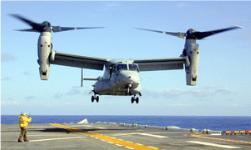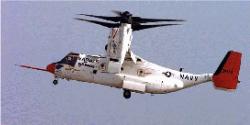V-22 Osprey Tilt-Rotor* |
| The V-22 is a joint service, multi-mission
aircraft with vertical take-off and landing (VTOL) capability. It performs
VTOL missions as effectively as a conventional helicopter while also
having the long-range cruise abilities of a twin turboprop aircraft.
It can carry a maximum of 12 litter or 24 ambulatory casualties and 2 corpsmen. The aircraft is capable of flying in excess of 25,000 feet, however, the cabin is not pressurized. Casualties transported at this altitude will require supplementary oxygen for breathing and some may develop decompression sickness (nitrogen bubbles in the blood) on descent for landing. The likelihood of developing decompression sickness depends on many factors, including the altitude, duration of exposure, rate of descent, physical status of the patient, hydration status, and any pre-flight prophylaxis. For typical military patients in typical military settings, a one-hour flight at 25,000 feet might produce decompression illness in as many as 50% of patients. Flying at lower altitudes leads to a lower risk of decompression illness, even if the duration of exposure is longer. Flying at or below 10,000 feet essentially eliminates the risk. |
 V-22
|
*From Operational Medicine 2001, Health Care in Military Settings, NAVMED P-5139, May 1, 2001, Bureau of Medicine and Surgery, Department of the Navy, 2300 E Street NW, Washington, D.C., 20372-5300
Contents · Introduction · Learning Objectives · Textbook · Lectures · Procedures · Final Exam · Library · Laboratory · Pharmacy · Imaging · Forms · Videos · Search · About the Author · Contact Us
Military Obstetrics & Gynecology
© 2005
Medical Education Division,
Brookside Associates, Ltd.
All rights reserved
